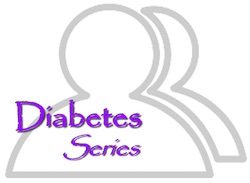


|
|

Click Here to download this Diabetes package in zipped format.
Diabetes Series:
For GENERAL Audiences
Overview. As an introduction to the diabetes series, this module provides a thorough description of type 1, type 2, and gestational diabetes. Practical skills for managing diabetes are discussed, along with diagnosis options.
A guide for patients. This module gives a thorough overview of the three main types of diabetes (Type 1, Type 2, and gestational), and also provides information on pre-diabetes. Risk factors and diagnosis methods are discussed for each type.
A guide for caregivers. This module provides practical information for caregivers of diabetes patients, including an overview of diabetes, tips for administering insulin, and how to care for children and teenagers with diabetes. The final portion of this module gives caregivers some ideas on how to take care of themselves as well, as the importance of doing so is emphasized.
A guide for health care providers—Part 1. This module gives a brief overview of type 1 diabetes, type 2 diabetes, and gestational diabetes. Methods to maintain metabolic control (glycemic levels, blood pressure, and cholesterol) are discussed, as well as cardiovascular disease prevention tips.
A guide for health care providers—Part 2. This module assists health care providers in discussing important topics and promoting a healthy lifestyle to diabetes patients. Some of the risks of diabetes are introduced as well, including how it affects the eyes, feet, and gums.
A guide for health care providers—Part 3. This module provides greater detail on oral health risks caused by diabetes, including periodontal disease. Drug therapy management is also discussed, emphasizing the importance of correct dosages and avoiding negative drug interactions.
Eating and diabetes—Part 1. This module stresses the importance of wise food choices and portion sizes to keep blood glucose in target range. Blood glucose levels are explained in depth, as well as the effects of low blood glucose (hypoglycemia).
Eating and diabetes—Part 2. This module continues to cover the main food groups (following the previous module’s explanation of starches, vegetables, and fruits), including milk, meat and meat substitutes, and fats and sweets. Instructions on how to construct a meal plan and how to determine serving sizes are also explained.
Gestational diabetes. This module defines gestational diabetes (found for the first time when a woman is pregnant), including how it will affect the newborn. Detailed treatment methods are also discussed.
Keep your diabetes under control. This module explains the importance of physical exercise, checking blood glucose levels, checking blood pressure, checking cholesterol and blood fat levels, avoiding or quitting smoking, and other prevention methods. The module concludes with daily methods for diabetes patients to maintain health and prevent problems from arising.
Keep your eyes healthy. This module focuses on how to prevent diabetes-related eye problems, including damage to the retina, and transitions into prevention methods and treatment options.
Keep your feet and skin healthy. This module describes how diabetes can cause damage to feet (by nerve damage and poor blood flow). Skin problems (caused by lack of fluids and nerve damage) are also discussed, along with practices to prevent both foot and skin problems.
Keep your heart and blood vessels healthy. This module provides an overview of the function of the heart and blood vessels, along with methods to prevent heart disease and stroke.
Keep your kidneys healthy. This module provides an overview of the functions of the kidneys, discusses kidney problems and damage caused by diabetes, provides prevention tips, and lists common signs of kidney failure.
Keep your nervous system healthy. This module begins with an overview of the nervous system and diabetic neuropathy (damage to the nervous system from diabetes). Potential damages to the peripheral nerves, autonomic nerves, and cranial nerves are discussed, along with prevention tips, symptoms, and treatment options.
Keep your teeth and gums healthy. This module describes some of the effects of diabetes in the teeth and gums, including plaque, germs, and periodontitis. Damage detection is explained, along with tips for keeping teeth and gums healthy.
Physical activity and diabetes. This module demonstrates how physical activity can help to control diabetes, providing applicable ways to be more active in everyday life. The benefits of aerobic exercise, strength training, and stretching are listed, as well as precautions to take when exercising.
